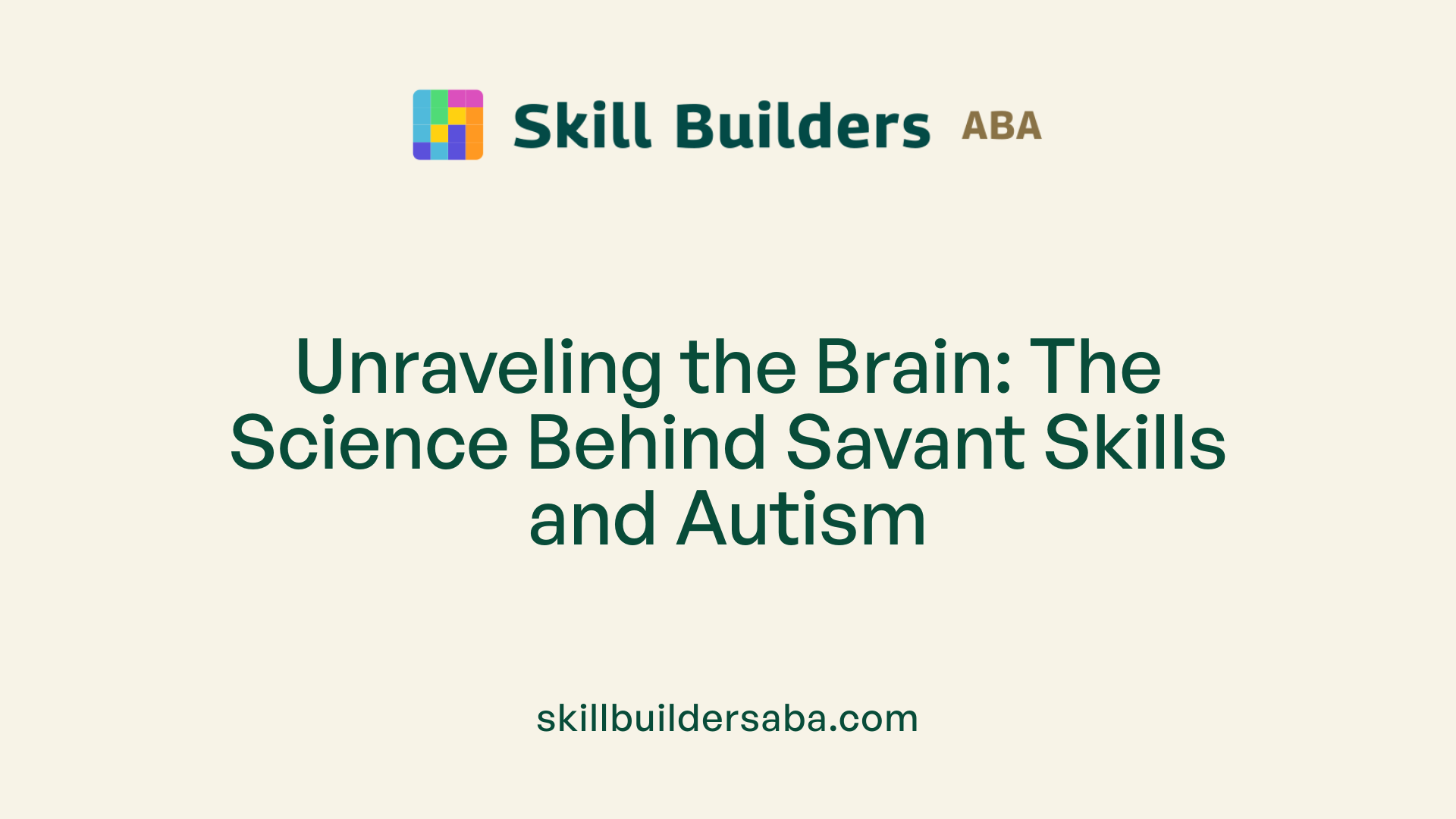
Autistic Savant
Unlocking Hidden Genius: Inside the World of Autistic Savants
An Exploration of Extraordinary Talents Within the Autism Spectrum
Autistic savants are among the most fascinating phenomena in neurology and psychology, captivating researchers and the public alike with their remarkable talents. These individuals, often living with autism spectrum disorder (ASD), display extraordinary skills in specific areas such as music, art, memory, or mathematics—abilities that often surpass even those of non-autistic prodigies. This article delves into the nature of savant syndrome, its connection with autism, characteristic traits, notable cases, scientific theories explaining these abilities, and their profound impact on individuals' lives.
Understanding Savant Syndrome: Definition and Relationship with Autism
What is savant syndrome, especially in relation to autism?
Savant syndrome is an uncommon condition where individuals, often with developmental challenges, exhibit extraordinary talents or skills. These remarkable abilities are typically in areas like music, art, mathematics, or exceptional memory. Many of these individuals are diagnosed with autism spectrum disorder (ASD), making the syndrome more recognizable within this condition. It is possible for savant skills to be present from birth (congenital) or to develop after brain injury or illness (acquired).
Researchers estimate that about 10% of people with autism have some form of savant skills, which include simple memorization of trivia or more complex talents like perfect pitch or detailed artistic drawing. Savant syndrome is predominantly observed in males, with a ratio of approximately 6 males to 1 female.
Common savant abilities include:
- Artistic talents like painting or sculpting
- Musical abilities, often involving perfect pitch
- Mathematical skills, such as rapid calculation
- Calendar calculating, where individuals determine days of the week for any date
- Exceptional memory and spatial skills
Prevalence in individuals with autism
Within the autism community, savant skills are relatively more prevalent than in the general population. Studies suggest that between 10 to 37% of autistic individuals may demonstrate some level of savant ability, which points to a significant overlap. Many autistic savants show heightened sensory sensitivities, obsessive behaviors, and systemizing traits, which may play a role in their extraordinary skills.
Interestingly, these abilities usually appear early in childhood and tend to improve with practice. While many with autism display strong visual or auditory memory, not all manifest these talents overtly. The relationship between autism and savant syndrome is complex and still under investigation, with current thought leaning toward neurobiological factors affecting brain connectivity.
Congenital vs acquired savant skills
Savant skills can be classified as either congenital or acquired. Congenital savants are born with their abilities, displaying talents from an early age. Conversely, acquired savant syndrome develops after brain injury, strokes, or neurodegenerative diseases, temporarily or permanently enhancing certain skills.
For example, individuals like Leslie Lemke, who developed musical talent after brain damage, exemplify acquired savant syndrome. The different developmental pathways suggest that brain plasticity and injury can sometimes unlock hidden talents, challenging traditional views of neurodevelopment.
Theories behind the origins of savant abilities
Although the precise causes of savant syndrome remain elusive, multiple theories aim to explain its emergence.
- Biological-developmental theory: Proposes genetic factors and atypical brain development underpin these abilities, especially in the right hemisphere.
- Modularity of mind hypothesis: Suggests that the brain contains specialized modules that can operate independently, leading to isolated exceptional abilities when certain areas are overactive or damaged.
- Cognitive theories: Focus on how hypoactivity in the frontal lobes may suppress executive control, thereby releasing talents in specific domains.
Research also points to an imbalance between the left and right brain hemispheres, with some studies showing that damage to areas of the left brain, which is involved in language and logical reasoning, may allow right-brain functions, related to visual-spatial and artistic skills, to dominate.
Understanding these mechanisms aids both scientific knowledge and educational strategies, promoting support for individuals with savant syndrome and autism.
Characteristics, Signs, and Traits of Autistic Savants

What are the characteristics, signs, and traits of autistic savants?
Autistic savants are individuals on the autism spectrum who display remarkable capabilities in specific areas such as art, music, memory, calculus, or spatial skills. These abilities often surpass what is expected based on their overall level of cognitive functioning. Typically, savants exhibit intense focus and dedication to developing their skills, sometimes demonstrating obsessive preoccupations that support their talents.
A prominent trait among autistic savants is heightened sensory sensitivity. For example, many have an exceptionally keen ear for music, with some possessing perfect pitch. Others might be able to recall vast amounts of information or produce detailed artistic work with great precision.
In addition to extraordinary skills, they often show distinctive cognitive patterns. Many have a preference for local processing, meaning they focus on details rather than the big picture. This detailed-oriented approach is especially evident in their artwork, where they may craft highly detailed drawings by working from part to part rather than sketching an outline first.
Systemizing, the drive to analyze, construct, and predict systems, is commonly observed and linked to their talents. Autistic savants often excel in tasks like calendar calculating, capable of determining the day of the week for any date swiftly and accurately. Their exceptional memory also plays a major role, enabling them to memorize entire books, music compositions, or complex calculations.
These traits coexist with social or communication challenges typical of autism, but the ability to develop and enhance their skills through practice is common. The combination of sensory sensitivities, obsessional behaviors, detailed processing, and outstanding memory forms the core of their distinctive profile.
Overall, these signs reveal a complex picture where profound impairments coexist with islands of extraordinary ability, often associated with lifelong congenital traits or development through intense engagement and focus.
Prevalence and Notable Examples of Autistic Savants

How rare are autistic savants and what percentage of individuals with autism have savant abilities?
Autistic savants are relatively uncommon, with estimates indicating that between 0.5% and 10% of people with autism spectrum disorder (ASD) possess savant-like abilities. Specifically, approximately 10% of children diagnosed with autism show some form of savant skills, though the percentage can vary based on study methods and populations.
Overall, savant syndrome affects about one in a million people in the general population. Interestingly, nearly half of these cases occur in individuals with autism, highlighting a strong association between ASD and savant skills.
Within the autism community, the prevalence of savant abilities is significantly higher among those with higher intellectual functioning. Males are notably more affected than females, with a ratio of approximately 6 males for every female exhibiting savant skills.
While savant abilities are rare in the broader society, they are more frequently observed within the autism spectrum, yet they still represent a small minority. These abilities, ranging from musical talent to exceptional memory, provide valuable insights into brain capabilities and neurodiversity.
How Autistic Savants Acquire and Develop Their Skills
What neurological factors influence skill development?
Autistic savants often develop their exceptional talents through unique brain wiring and functioning. Researchers suggest that differences in brain regions, especially the temporal lobes, play a role in their abilities. The left anterior temporal lobe, in particular, has been linked to savant skills, with damage or atypical activity in this area associating with extraordinary capabilities.
Studies also indicate that the right hemisphere of the brain may compensate for deficits in the left, leading to enhanced abilities such as detailed visual-spatial skills or musical talent. These neurological variations contribute to a distinct information processing style characterized by heightened local focus and attention to detail, which are vital for the development of specific savant skills.
Spontaneous emergence vs learned ability
Savant skills may appear spontaneously, especially in congenital savants who show remarkable abilities early in life, often without formal training. This spontaneous emergence might be linked to neurodevelopmental differences that create 'islands of genius' amidst broader developmental challenges.
Alternatively, some abilities can be cultivated through practice and obsessional focus. Autistic savants often display intense dedication and repetitive engagement in their interest areas, which significantly improves their talent. This practice-driven development is supported by their obsessive traits and heightened sensory sensitivities, fostering rapid mastery of specific skills.
The role of brain regions like the temporal lobes
The temporal lobes are crucial in processes like memory and perception, and their atypical functioning is frequently observed in savants. Damage or developmental differences here facilitate extraordinary memorization and calculation skills.
In cases of acquired savant syndrome—where talents emerge after brain injury—this damage can temporarily or permanently alter neural pathways, unlocking abilities previously dormant or making new connections possible.
Practice and obsessional focus in talent growth
Many autistic savants spend a significant amount of time practicing and obsessively focusing on their talents. This relentless dedication can enhance neural connections and reinforce skill development.
While some theories posit practice alone as the key to developing savant skills, evidence suggests that obsessional traits and sensory sensitivities also play critical roles. These traits enable sustained attention and motivation, resulting in rapid and often spectacular skill acquisition.
| Aspect | Contribution | Notes |
|---|---|---|
| Brain regions | Structural differences in temporal lobes | Critical for memory, perception |
| Developmental timing | Spontaneous or post-injury | Early development or acquired |
| Practice | Repetition and focus | Enhances and refines skills |
| Obsessional traits | Motivation and persistence | Drive skill mastery |
Notable Cases of Autistic Savants and Their Talents

What are some notable cases and examples of autistic savants?
Autistic savants are individuals with autism spectrum disorder who display extraordinary talents or skills, often in specific areas like art, music, or mathematics. Some of the most famous examples include Kim Peek, Stephen Wiltshire, Daniel Tammet, Leslie Lemke, and Alonzo Clemons.
Kim Peek was a man with savant syndrome who memorized over 12,000 books and could recall details from them effortlessly. His incredible memory inspired the character Raymond in the film 'Rain Man,' highlighting his exceptional ability in information recall.
Stephen Wiltshire is known for his detailed sketches of cityscapes. After viewing an aerial shot once, he can draw an intricate cityscape from memory, demonstrating prodigious visualization skills. Diagnosed with autism early in life, Wiltshire developed his drawing talent into an internationally recognized art form.
Daniel Tammet stands out for his extraordinary number skills, such as reciting over 22,000 digits of Pi and learning new languages rapidly. He also experiences numbers through a form of synaesthesia, where he visualizes them as shapes and colors, adding a sensory dimension to his mathematical prowess.
Leslie Lemke, despite being blind and having autism, can play complex pieces on the piano after hearing them just once. His musical talent is remarkable given the lack of formal training, and his ability exemplifies the musical savant skill.
Alonzo Clemons, who suffered a head injury as a toddler, developed an extraordinary talent for sculpture. He can create highly detailed and accurate sculptures of animals, even after brief exposure to their images. His artistic skill is a testament to how specific talents can emerge in savants.
These individuals exemplify the range of talents seen in autistic savants, from memory and art to music and calculation. Their abilities provide insight into the potential of the human brain and how specific skills can develop despite significant neurodevelopmental challenges.
Scientific Theories, Neural Basis, and Cognitive Features of Autistic Savants

What are the scientific theories, research findings, and cognitive features associated with autistic savants?
Autistic savants exhibit extraordinary abilities in areas such as music, art, mathematical calculations, and memory. Characterized by detailed-focused perception and massive memory, these talents often emerge in individuals with ASD. Various scientific theories explain these skills by examining brain structure and function.
One prominent theory involves atypical neural connectivity. Research indicates that savant abilities may stem from differences in how brain regions communicate, particularly involving disruptions between the left and right hemispheres. Neuroimaging studies, including MRI, PET scans, and diffusion tensor imaging, have revealed that savants often display structural differences, such as altered connectivity patterns and localized brain specialization.
In terms of hemispheric involvement, findings suggest that dysfunction in the left hemisphere—responsible for language and logical skills—may be present alongside compensatory activity in the right hemisphere, which is associated with visual-spatial and artistic processing. For example, decreased activity in the left temporal lobe has been linked to enhanced artistic or musical abilities.
Cognitive features typical of autistic savants include weak central coherence, meaning they tend to process details rather than integrating information globally. This trait allows for remarkable focus on specific elements, such as musical tones or visual details. Enhanced perceptual functioning also plays a role, where sensory sensitivities and heightened awareness contribute to their skills.
Moreover, theories of hyper-systemizing—an inclination to analyze or construct systems with great detail—align with observed strengths in mathematical and logical tasks. These cognitive styles are often supported by neuroplasticity, enabling the brain to adapt and develop specialized circuits for these talents.
Empirical evidence from neuroimaging demonstrates these differences, highlighting that savant skills are rooted in unique neural profiles. They can arise congenitally or after brain injury, emphasizing the brain's plasticity. Educational and therapeutic approaches often harness these neural and cognitive strengths to support skill development.
| Neural Aspect | Finding | Implication |
|---|---|---|
| Brain connectivity | Altered patterns between hemispheres | Highlights unusual processing pathways |
| Left hemisphere | Dysfunction in language-related areas | Facilitates artistic/musical talents |
| Right hemisphere | Increased activity | Supports visual-spatial skills and creativity |
| Brain structure | Localized regions show increased activity | Suggests specialization and plasticity |
How do these insights impact our understanding of neurodiversity?
Understanding the neural and cognitive underpinnings of savant syndrome broadens our appreciation of neurodiversity. It illustrates how the brain's unique wiring can give rise to remarkable talents, even amidst developmental challenges. Recognizing these differences encourages supportive education and reduces stigma by emphasizing strengths rather than deficits.
Distinguishing Autistic Savants from Autism and Addressing Stereotypes

How does savant syndrome differ from autism, and what are common stereotypes?
Savant syndrome is a rare condition characterized by extraordinary abilities or talents in specific domains such as music, art, mathematics, or memory. Individuals with savant syndrome often have developmental disorders, most commonly autism spectrum disorder (ASD), but the two are not the same.
While a significant portion of savants—roughly 10 to 50%—also have autism, not all autistic individuals display savant skills. Conversely, not all savants are on the autism spectrum; some develop their exceptional talents after brain injuries or other neurological conditions. This distinction is crucial to understanding the phenomenon.
Popular stereotypes tend to portray all autistic people as possessing extraordinary talents, often imagining these abilities as constant or superhuman. This misrepresentation is misleading. In reality, savant skills are rare, usually narrow in scope, and exist on a spectrum. Many autistic individuals do not have any savant abilities, and those who do may only demonstrate a specific talent alongside social or communication challenges.
Common stereotypes suggest that savants excel effortlessly with abilities like memorization, perfect musical pitch, or detailed drawing. While some prodigies do display remarkable skills, many others must work diligently, and their talents can fluctuate or even disappear. These misconceptions contribute to misunderstandings and unrealistic expectations about autism and savant syndrome.
Understanding the difference helps promote a more accurate view of neurodiversity—recognizing that extraordinary talents can coexist with developmental difficulties, but they are not defining features for most autistic people. Raising awareness about this distinction is essential to dispel harmful stereotypes and to foster better support for individuals with various abilities.
Celebrating Neurodiversity and Recognizing Unique Gifts
The world of autistic savants reveals the remarkable potential nested within neurodiversity. While these extraordinary talents are rare, they challenge our understanding of intelligence, learning, and the human mind’s incredible capacity for specialization. Recognizing and supporting the development of these unique abilities can profoundly impact individuals' lives, fostering confidence, identity, and societal acceptance. As research progresses, so too does the appreciation for the complex neural architecture that underpins these exceptional skills, emphasizing that diversity in cognition is not only natural but also an invaluable asset.
References
- Savant syndrome - Wikipedia
- Savant Syndrome | SSM Health Treffert Center
- The savant syndrome: an extraordinary condition. A synopsis
- Why are savant skills and special talents associated with autism?
- Savant Syndrome: What Is It, Causes, Treatment, and More | Osmosis
- Understanding Savant Syndrome - Verywell Mind
- “Autistic savant”: A rare case report - LWW
- 5 amazing people with savant syndrome - Aruma
- Savant syndrome: What it is, symptoms, and links to autism
- What is an Autistic Savant (or Savantism)?
Reach Out Today
Learn more about how we can support your child’s growth and development. Contact us to discuss our services and availability in your area.
.svg)